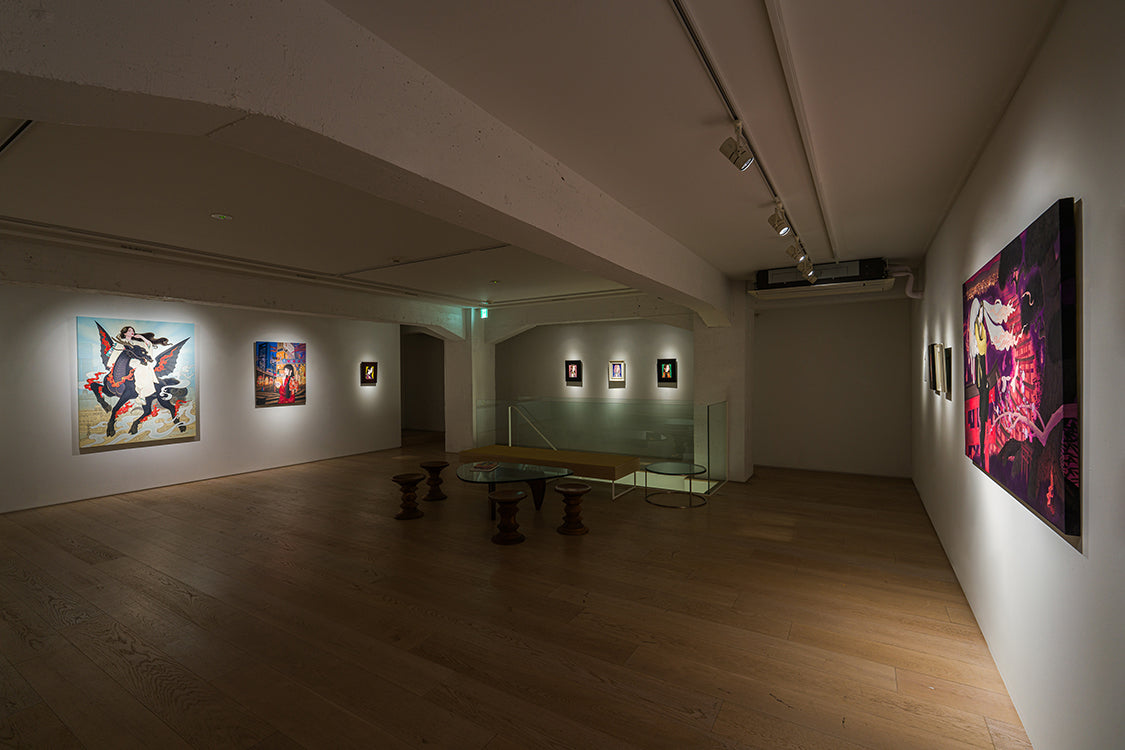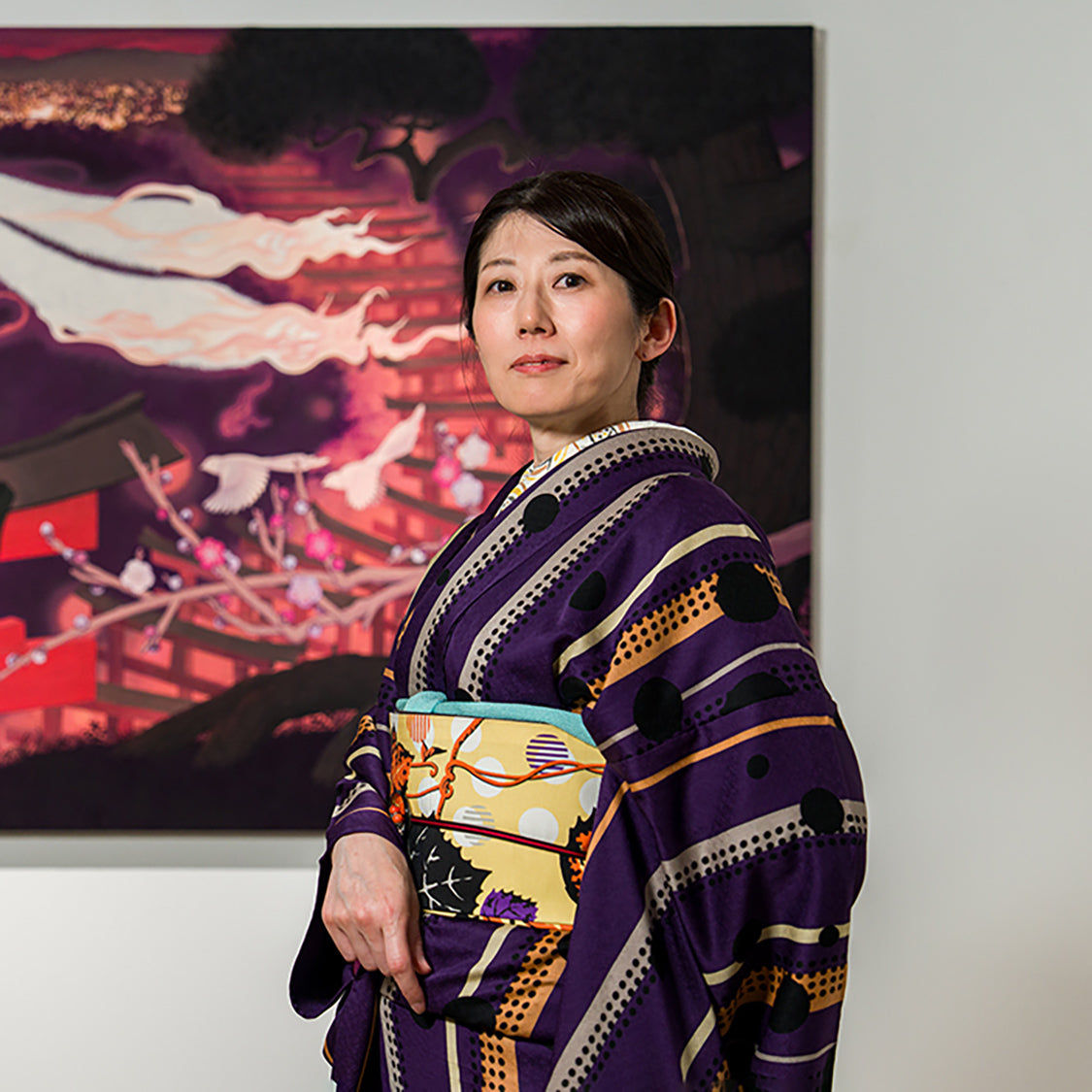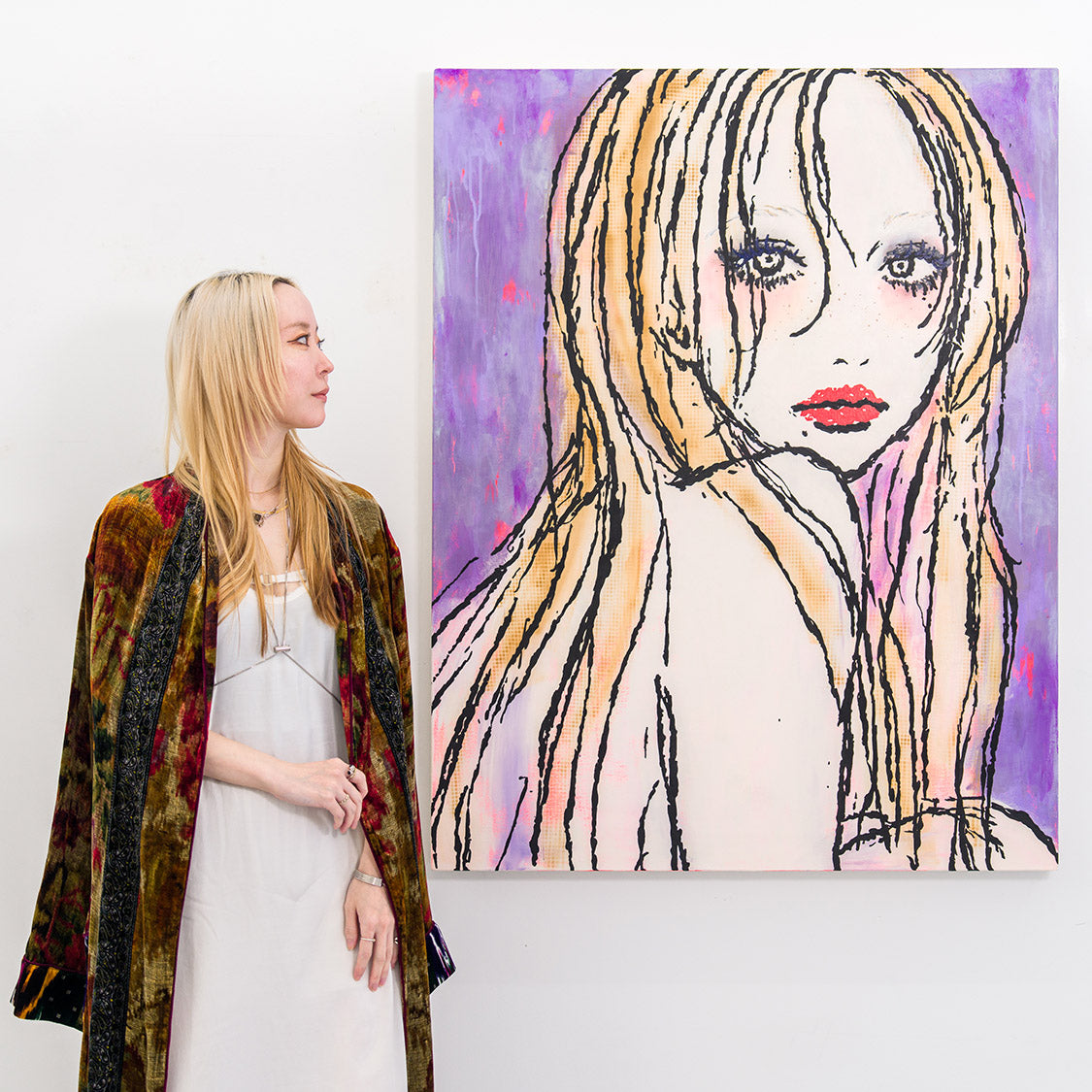Whitestone Ginza New Gallery is pleased to announce “Real Women - Through the Passage of Time”, a duo exhibition featuring female artists Miki Katoh and itabamoe.
The artist Miki Katoh depicts traditional Japanese culture, kimono, and historical landscapes through her unique perspective. Her works are inspired by antique kimonos from the Taisho and early Showa periods, incorporating designs that delicately express the freedom and beauty of women. Reflecting Japanese animistic beliefs, her life-affirming, prayer-like art depicts humans, plants, and animals as symbolic beings, with some taking on human forms while others transform into various shapes. In her "100 Views of Tokyo" series, she applies Edo ukiyo-e techniques to depict Tokyo's landscapes in a fable-like manner, weaving a narrative that links history with the future. Her latest works explore the passage of time, expressing changes in landscapes and history, as well as the accumulation of people's wishes. By blending tradition with modernity, her work contributes to the preservation and development of Japanese culture while also reflecting the changes in women's lives throughout the ages, celebrating their beauty and strength.


Real Women - Through the Passage of Time: MIKI KATOH, itabamoe
Ginza New Gallery
2025.04.04 - 04.26


2025
Acrylic gouache, Canvas
112.0 × 145.5 cm
The kirin, with a high-pitched gallop, soars across past, present, and future. Every principle has its “beginning” and “end.” With each “end” invites a new, unknown “beginning.”
Now is the time—hold onto your convictions and rise skyward.
The winged kirin resides at Nihonbashi, the origin point of all roads in Japan. Its wings symbolize the wish to spread forth from here across the nation.
Nihonbashi has long been a crossroads where people, goods, and culture intersect from the Edo period to the present day. The elms and pines once marking distance along highways now adorn pillars, evoking travel and the passage of time.
As redevelopment opens up the skies above, the artist sees every end as a new beginning and imbues this work with the will to soar into the future with steadfast belief.
2024
Acrylic gouache, Canvas
91.0 × 72.7 cm
This is the mysterious entrance of Shinbashi, where at twilight the gates to another realm open. Come, let us share a drink—but be warned, what sits beside you may not be human. You do not know who I am.
A fast-asleep drunken dragon drops a glowing orb—an all-powerful treasure granting any wish. Once stolen by a wicked dragon, it is now my secret prize, reclaimed in silence. The foolish dragon cries, wailing for its missing orb. So then, what shall I wish for?
At the twilight hour, a mysterious alley appears in Shinbashi. This fantastical tale about a jewel dropped by a drunken dragon draws inspiration from the legend of “Tama-Orihime” of Sanuki, reimagined in modern Tokyo.
Set in Shinbashi, a city steeped in intoxication and desire, the story is told from the perspective of a mysterious narrator encountering beings beyond humans.
At the heart of this piece is the power held within the orb, and the question of what one truly wishes for upon possessing it—a reflection on human vulnerability and strength.
Blending myth with modernity, the work becomes a prayer and beacon of hope for navigating a chaotic age.
2024
Gouache, Natural mineral pigments, Dyed mud pigment, Watson paper, Wood panel
22.8 × 16.0 cm
“Saika” is a series that celebrates the joy of color.
Though composed with the same structure, subtle differences in color and pattern shift the impression—inviting the viewer to explore their personal preferences.
The “large-head portraits” (ōkubi-e) of the Edo period were hugely popular for depicting beloved actors and courtesans in dramatic close-ups. Techniques like kirazuri, which added shimmering mica to pigments, enhanced the viewer’s enjoyment.
Similarly, the “Saika” series presents vivid bust portraits of women in gouache, allowing close observation of their expressions. The vibrant patterns serve as accents within a space, while the mineral pigments used in the background offer a uniquely shimmering texture—an experience only possible when seen in person.
These works transform traditional Japanese beauty into contemporary art. That is the essence of “Saika.”
This particular piece, titled *Ukonkō*, takes its name from the word for “tulip.”
2024
Gouache, Natural mineral pigments, Dyed mud pigment, Watson paper, Wood panel
22.8 × 16.0 cm
“Saika” is a series that celebrates the joy of color.
Though composed with the same structure, subtle differences in color and pattern shift the impression—inviting the viewer to explore their personal preferences.
The “large-head portraits” (ōkubi-e) of the Edo period were hugely popular for depicting beloved actors and courtesans in dramatic close-ups. Techniques like kirazuri, which added shimmering mica to pigments, enhanced the viewer’s enjoyment.
Similarly, the “Saika” series presents vivid bust portraits of women in gouache, allowing close observation of their expressions. The vibrant patterns serve as accents within a space, while the mineral pigments used in the background offer a uniquely shimmering texture—an experience only possible when seen in person.
These works transform traditional Japanese beauty into contemporary art. That is the essence of “Saika.”
In this piece, *Saika No.6 Blue Rose*, a woman with a straight bob hairstyle dons a kimono adorned with vivid blue roses. She appears both graceful and strong.
2024
Gouache, Natural mineral pigments, Dyed mud pigment, Watson paper, Wood panel
22.8 × 16.0 cm
“Saika” is a series that celebrates the joy of color.
Though composed with the same structure, subtle differences in color and pattern shift the impression—inviting the viewer to explore their personal preferences.
The “large-head portraits” (ōkubi-e) of the Edo period were hugely popular for depicting beloved actors and courtesans in dramatic close-ups. Techniques like kirazuri, which added shimmering mica to pigments, enhanced the viewer’s enjoyment.
Similarly, the “Saika” series presents vivid bust portraits of women in gouache, allowing close observation of their expressions. The vibrant patterns serve as accents within a space, while the mineral pigments used in the background offer a uniquely shimmering texture—an experience only possible when seen in person.
These works transform traditional Japanese beauty into contemporary art. That is the essence of “Saika.”
This piece, *Saika No.3 Yurirokushō*, features lilies. The name comes from the pale blue used in the background, which evokes the color of rokusho pigment.
2024
Acrylic gouache, Canvas
53.0 × 41.0 cm
Even as a faint starlight twinkles in the twilight sky, and a soft glow flickers in the twilight city below, I continue to wait. I no longer know what I am waiting for.
Petals drift like rafts on the river’s surface, dissolving into the unreliable light and carrying my breath toward the sea. Countless lights shimmer. Even as eternity flows by.
Since the Edo period, cherry blossoms have bloomed magnificently along the Sumida River, a tradition that continues today.
This work was inspired by Utagawa Hiroshige’s ukiyo-e, “Masaki, Grove of the Water God, and the Sumida River,” aiming to harmonize and fuse the famed Edo location with contemporary art.
The Grove of the Water God is still cherished today as the Sumida River Shrine, conveying the cycle of life through the vast flow of time.
Through the beauty of things that fade and cherry blossoms that continue to bloom in memory, this piece expresses a hope that connects past, present, and future.

Portraying Womanhood, Enrobed in Culture: Interview with Miki Katoh
ABOUT

Born in Saitama, Miki Kato graduated from Joshibi University of Art and Design. Initially working as an illustrator, she began pursuing painting with her first solo exhibition produced by Hisashi Tenmyouya in 2012. In contrast to the traditional kimono design, the women in Kato’s portraits wear modern and innovative kimonos inspired by the “vintage kimonos” of the Taisho and early Showa era. Her styling is glamorous and liberated, expressing not only visual pleasure but also the attitude and the spirit of independent women. It goes without saying that kimono designs reflect the trends and tastes of each period. However, the landscapes and cityscapes depicted in the background of her works subtly incorporate historical buildings, allowing the viewer to imagine the changes through time alongside the figure portrayed. Furthermore, Kato’s works, rooted in the epic traditions of Japanese culture, are deeply connected to numerous myths, fables, animisms, and to the cycle of life and reincarnation. Her unique space-time setting focuses on the exploration of “nature and the cycle of life”, not only cleverly blending the flow of time and the coexistence of old and new, but also the idea of “boundaries”, of the ordinary and the extraordinary, as well as reality and other worlds. This forms a profound viewpoint that is in contrast with her seemingly clear and concrete brushwork.
Currently, in addition to holding solo and group exhibitions both domestically and internationally, Kato is showcasing her excellent aesthetics as a designer by creating new kimonos in collaboration with long-established kimono manufacturers.
itabamoe's works aim to reconstruct the visual representations of women shaped in the advertising industry into contemporary art. Transitioning from the organic youth culture of the 90s to the digital age, she presents a new perspective on the "image of women" in contemporary society. While working as an illustrator and contributing to commercial icons, her art strives to go beyond those boundaries. By focusing on the diversity of women’s images shared through social media and digital platforms, she emphasizes the inner charm that radiates, rather than just outward appearance. Her art expresses a "new beauty" that is not bound to gender or societal expectations. The women on her canvases rebel against societal stereotypes, embodying strength and freedom that emanate from within. She combines the clarity of visual language with the ambiguity of art, allowing for layered interpretations. This prompts viewers to reconsider modern values and standards of beauty, offering an opportunity to recognize their own as well.


ABOUT

itabamoe is a contemporary artist based in Tokyo. After graduating from Bunka Fashion College, she started her career as an apparel designer, then shifted to the advertising industry as an illustrator. She has been active as an artist since 2021. itabamoe reconstructs illustration as a subject of contemporary art by incorporating and developing the diverse representations of women that have been cultivated in the advertising industry. She has continuously expressed the multi-dimensional images of the ‘ideal woman’ that continue to change through the passage of time. The process, in which the details of everyday life are buried in the world of advertising, becomes the core of the subject. It reflects the social and cultural history of the 20th century, including the redefinition of marginalities such as gender, race, and the third world, and also links to the personal trajectory of the artist herself. While posing to reflect the era of social media, in which anyone can play the leading role, the pop and visually articulated style of itabamoe powerfully affirms the virtues that make up each individual’s inherent beliefs and way of life.
Miki Katoh and itabamoe depict the evolution of the modern image of women, though their approaches are different. Katoh expresses the image of women incorporating Japanese culture and historical backgrounds, weaving stories rooted in time and culture. In contrast, itabamoe, takes influence from the digital age, exploring the diverse representations of women found in the world of social media and advertising. Both artists' works resonate with the changes in society and highlight the inner lives of women. We invite you to take this opportunity to explore their pursuit of "real" female imagery and the passage of time they present.


2025.04.04 - 04.26
银座新馆
Tel: +81 (0)3 3574 6161
Fax: +81 (0)3 3574 9430
Opening Hours: 11:00 - 19:00
Closed: 周日,周一














